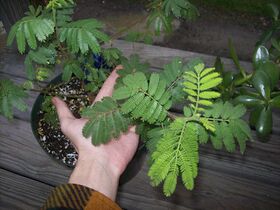Mimosa tenuiflora
 |
This article is a stub. As such, it may contain incomplete or wrong information. You can help by expanding it. |
Mimosa tenuiflora (or Mimosa hostilis) also known as Jurema, is a perrenial shrub indigenous to northeast South America, more commonly in lower altitudes. The dried root bark may contain up to 1.0 to 1.7% DMT[1] It has been used by indigenous peoples of South America for use in Ayahuasca brews, typically combined with Banisteriopsis caapi or another plant source of beta-carboline MAOIs (specifically Reversible Inhibitors of MAO-A, or RIMAs such as the Harmala alkaloids.[2] It is also used as a source of DMT for extraction in modern times, and as an admixture for ayahuasca brews in both ancient and modern contexts. Although no beta-carbolines have been detected in M. tenuiflora samples, it exhibits psychoactivity when taken alone, suggesting an alternate mechanism than the DMT it contains, which would otherwise be rapidly metabolized by the MAO-A enzyme, rendering it virtually inactive (at least from its DMT content). In 2005 the alkaloid Yuremamine was isolated from root bark samples, and is considered the first compound in a new family of of phytoindole compounds.[3]
| Mimosa tenuiflora | |
|---|---|
 |
|
| Taxonomical nomenclature | |
| Kingdom | Plantae |
| Unranked | Angiosperms |
| Unranked | Eudicots |
| Unranked | Rosids |
| Order | Fabales |
| Family | Fabaceae |
| Genus | Mimosa |
| Species | tenuiflora |
| Common nomenclature | |
| Synonyms | Mimosa hostilis |
| Common names | Jurema Preta, Calumbi, Tepezcohuite, Carbonal, Cabrera |
| Constituents | |
| Active constituents | DMT |
- ↑ Encyclopedia of psychoactive plants. Botany, ethnopharmacology and applications. Aarau: AT-Verl. P. 15. ISBN 978-3-85502-570-1.
- ↑ Ayahuasca Analogues: Pangaean Entheogens (1995), ISBN 0-9614234-4-7
- ↑ Vepsäläinen, J. J.; Auriola, S.; Tukiainen, M.; Ropponen, N. & Callaway, J. (2005). "Isolation and characterization of Yuremamine, a new phytoindole". Planta Medica. 71 (11): 1049–1053